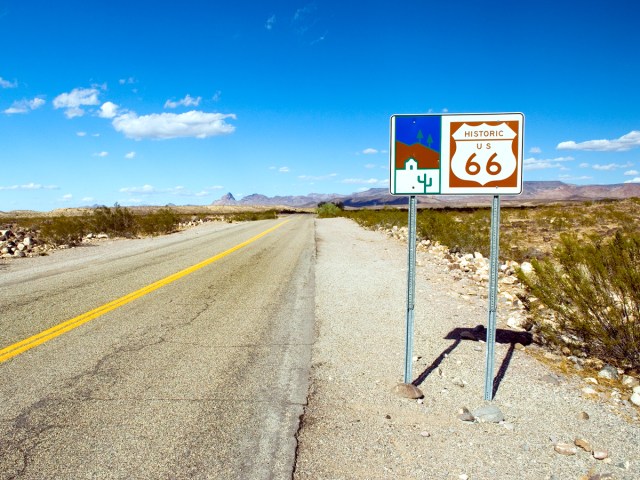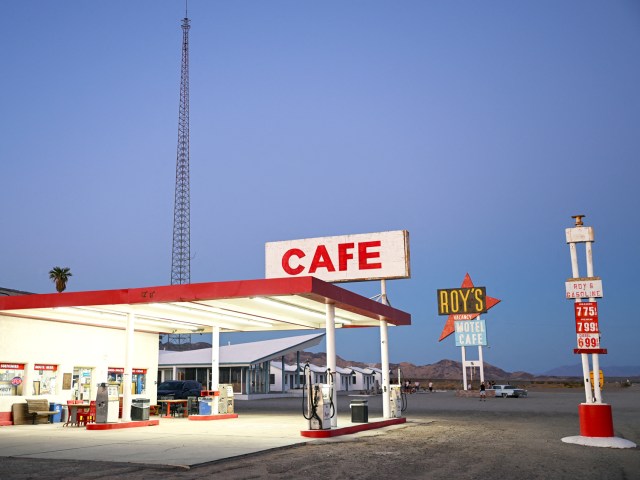Route 66 holds a special place in U.S. history. Stretching from the Midwest to Southern California, the iconic highway was one of the earliest of its kind, connecting a swath of cross-country landscapes and communities for the first time. Today, its significance extends beyond its function as just a road — the once-essential highway symbolizes an early 20th-century spirit of aspiration, opportunity, and an idealization of Americana. Discover the fascinating history of Route 66 and what makes it America’s most famous road.
Where It All Started

Route 66’s early origins date back to the Federal Aid Highway Act of 1916, a funding initiative that set the stage for the country’s eventual national highway system. In 1926, America’s independent transportation trails were integrated into a unified numerical system, the United States Numbered Highway System, and Route 66 was officially established. Advertised as “the shortest, best, and most scenic route from Chicago through St. Louis to Los Angeles,” the highway was planned to traverse 2,400 miles through eight states and three time zones. Its path was plotted along a loose combination of existing local, state, and national roads, a strategic route chosen to connect rural regions to major cities across the country.
Route 66 wasn’t the country’s first major paved highway — the Lincoln Highway, stretching 3,000 miles between New York and San Francisco, predated Route 66 by over a decade — but it was the first all-weather, year-round, fully paved highway. For a country growing increasingly infatuated with and reliant on the automobile, that made travel of all kinds more accessible.
An Instant Hit

Upon its completion in the late 1930s, Route 66 quickly became a vital corridor. It helped farmers in rural communities more easily transport their grain and produce, and it was a shorter route through more temperate climates for transport trucks between the Midwest and the Pacific coast.
The highway also served as a vital link for migrants heading west during the Great Depression and the Dust Bowl of the 1930s, when devastating dust storms ravaged crops in the country’s southern plains. While exact figures still remain a matter of debate, some estimates suggest upwards of 400,000 people sought refuge and new opportunities in California, many of whom were able to use Route 66. It was also a key military route. During World War II, equipment and personnel frequently traveled to bases in Missouri, New Mexico, Arizona, and California, all of which were established on or near Route 66.
Mythology Is Born

For all its useful purposes, Route 66 was more than a utilitarian throughway. In the prosperous postwar era, many Americans had affordable cars, paid vacation time, and reliable highways for the first time. They took to the road like never before, and for road-trippers in the 1950s and ’60s, Route 66 was the quickest path to the great American West that dominated their TV and movie screens. Yellowstone and the Grand Canyon were popular natural attractions, while Las Vegas and Los Angeles drew record numbers of people seeking sunshine and glamour.
Following the route’s popularity surge, roadside diners, motels, and attractions began to spring up across the country. Although author John Steinbeck had already dubbed Route 66 “the Mother Road” in his 1939 novel The Grapes of Wrath, it was Jack Kerouac’s 1957 book On the Road that cemented a generation’s love of road trips. Route 66 became more than just a road — it became a symbol of American optimism and adventure. Its popularity soared through the 1950s and ’60s, thanks in part to its portrayal in literature and music, including Nat King Cole’s “(Get Your Kicks On) Route 66.” Route 66 even had an eponymous 1960s TV series that romanticized the idea of a cross-country trek along the storied highway.
Keeping History Alive

By 1970, however, Route 66 was in decline. President Eisenhower, inspired by the efficiency of Germany’s Autobahn, had signed the Federal Aid Highway Act in 1956, and over the next decade, Route 66 underwent significant changes. Sections of the original road were gradually upgraded, bypassed, or entirely replaced by new multilane highways designed for higher speeds and heavier traffic. Throughout the 1970s, the famed route was mostly replaced by a series of interstate highways. In 1984, after the completion of Interstate 40, Route 66 was officially decommissioned.
Many of the the mom-and-pop shops and motels that relied on the Mother Road’s traffic faded away, but a new nostalgic experience took over. Since it lost its official highway status, historic associations, local governments, and businesses have worked to safeguard Route 66’s legacy, preserving landmarks and restoring the beloved kitschy vintage signage that dots its path. Several segments of Route 66 are now listed on the National Register of Historic Places, while others, like New Mexico’s sun-drenched slice of the legendary road, have earned National Scenic Byway designations.
Small towns along the route continue to celebrate their connection to Route 66 with festivals, museums, and annual events, ensuring that its legacy is preserved for future generations. Tourists along the famous trek are certainly less numerous than before, but now, the experience is all about quirkiness and nostalgia. For example, many flock to the Cadillac Ranch art installation in Amarillo, Texas, eager to leave their own mark on the graffiti-covered cars, while others visit some of the strip’s long-standing motels, such as the Wagon Wheel near Cuba, Missouri, or the Blue Swallow in Tucumcari, New Mexico. What these attractions lack in luxury, they more than make up for in atmosphere and history.
More from our network
Daily Passport is part of Inbox Studio, which publishes content that uplifts, informs, and inspires.
















